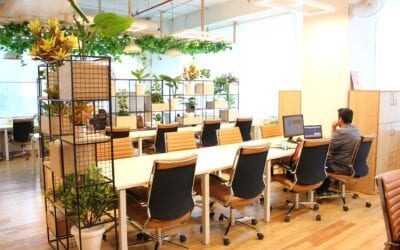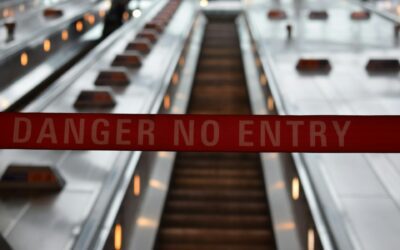|
|
Digital nomads have the luxury of working from anywhere, but where do they actually work from? Despite what posed photos on Instagram suggest few choose to work from the beach or a resort pool. No one wants sand getting into their laptop, the sun overheating, or the glare forcing them to squint at their screen.
So where do digital nomads really work?
According to a recent report by Flatio, the most popular places for digital nomads to get work done are from home, wherever that might be at any given moment (55.4%), coworking space (16.2%), and cafes (11.3%). These findings were supported by a poll of digital nomads on Reddit which showed 71% working from their accommodation, 10.5% from coworking spaces, and 13.5% from café.
But how can you ensure that these are actually productive places? Read on for our top tips for optimizing your workspace when you work from anywhere.
Home Office
For remote workers who work from a permanent home, their home office can feel as “optimized” as the traditional office. You might have your standing desk, ergonomic chair, monitor and keyboard extension, and dimming shades to block the afternoon sun. You may even have successfully trained family members or housemates not to disturb you during calls or key working hours.
Creating the ideal home office as a digital nomad is much more challenging because you are probably staying in short-term accommodation which you can only personalize to a certain extent. Plus, you usually have to manage with what is already in the space and what you can carry with you when traveling… so no standing desk or second monitor. Plus, depending on the type of accommodation, you might have limited control over what your neighbors or housemates do.
But there are things you can do to ensure the best possible workspace in your accommodation.
The first thing is a question of where you stay. How much space and quiet you need to be productive depends on you. Some people need a dedicated space to get in the zone and flow, while others find they can work almost anywhere as long as they have a pair of headphones. But if you are planning to work from your accommodation, based on your budget, consider the following.
Choose Your Accommodation with Care
While early digital nomads often stayed in hostels, increasingly Airbnbs and other private accommodations are becoming popular. This gives you more control over your space in terms of what it is used for and noise levels, plus just more privacy.
If you can’t stretch to private accommodation, at least look for options with people with a similar rhythm to you. This means you might want to skip the hostel with backpackers making noise all day and drinking all night. But a coliving space with other digital nomads might be a reasonable choice.
When looking at the accommodation, think about where you are going to work. In shared accommodation, is there a dedicated working area designated as a private zone? Will this work for you, even if you have to take calls? If you are in private accommodation, is there a space that you can turn into a workspace? This could be an empty bedroom, or a space in your own bedroom that you can designate for work.
Of course, also consider whether a decent internet connection is included or if this is something that you may be able to organize.
Get the Right Gear
Consider what gear you might need to convert some desk space in a corner into something that feels like a productive office space. This goes far beyond just your laptop and a good internet connection.
- Separate keyboard and mouse: These may seem like a luxury, but they will stop you from hunching over your keyboard and developing wrist problems. You can find super-slim and lightweight options.
- Foldable laptop stand: If you just work with your laptop on the table, again you will be forced to hunch forward to get your screen at a comfortable level. This kind of stand lets you raise your screen to eye level.
- Noise-canceling headphones: It is impossible to know in advance if your neighbors have screaming children or are in the middle of construction work. These will help you focus.
- Extension cord: You don’t know if power points will be well placed for where you want to work. There is also a chance that you will want to move around depending on the time of day and how the sun hits.
- Lumbar support cushion: Your accommodation is more likely to have dining chairs of basic office chairs than the ergonomic support you need for your back if you sit to work for several hours a day. Bring your own ergonomic seat cushion to protect your back and maintain your comfort. Also, take lots of breaks.
There may be other things that you feel like you need to make your office space comfortable. If you consider them essential, you will probably have to bring them with you. Fortunately, there are compact versions of almost everything these days.
Create a Routine
One of the biggest challenges when working from your accommodation is creating a clear divide between work and leisure. It can be hard to transition into work mode in the morning when you are in the same place that you slept. It can also be hard to transition out of work mode when you are still in your workspace.
When your living and workspace are one, you need to create other types of division between your living and workspaces. You might rely on a certain playlist to get you into the zone at the start of the day and rituals such as shutting down all work-related applications and muting notifications to draw a clear line under work when you are done.
The rituals that work tend to be very personal, so you need to find things that work for you. But drinking your coffee out of a special work mug, turning on a playlist, and going through the day’s to-do list are often good ways to get into the day. Shutting down and switching off notifications and engaging in some form of exercise can be good ways to exit the workday.
Don’t forget to get insurance when traveling
Ensuring you have reliable travel medical insurance is crucial for digital nomads. SafetyWing Nomad Insurance offers a unique solution tailored to the needs of remote workers. It provides comprehensive coverage for medical expenses up to $250,000, with a $0 deductible, making it a reliable choice for covering even the smallest claims. The pay-as-you-go subscription model, with billing every 4 weeks, makes it one of the most affordable options on the market. SafetyWing also covers travel delays, lost luggage, and trip interruptions, which are common concerns for nomads.
On top of this, you can add electronic theft insurance for up to $3000 worth of electronic valuables, providing peace of mind for those who travel with expensive equipment. Available in over 180 countries, SafetyWing ensures that you’re protected wherever you go. Purchasing the insurance is straightforward and can be done in just 5 minutes, even if your trip has already started. This flexibility, along with 24/7 online customer care, makes SafetyWing a practical and convenient choice for digital nomads looking to secure their health and travel needs while focusing on their work.
SafetyWing’s no pre-approval policy and the ability to cancel anytime further enhance its appeal to digital nomads. For families, children under 10 are covered for free with an adult policy, making it a cost-effective solution for budget-conscious travelers. All these features make SafetyWing Nomad Insurance a versatile and reliable choice for those living a nomadic lifestyle.
Coworking Spaces
If you find that you are most productive when working from a traditional office, and you enjoy the camaraderie of working alongside others, even when you aren’t collaborating, then coworking spaces are an excellent choice. They also tend to have a lot of the work facilities that you want, such as ergonomic chairs, additional monitors, quiet pods for calls, and more.
A coworking space can represent a commute, but this is not always a bad thing. It creates a clear division between leisure and work, and you get to enjoy daily life wherever you are staying as you make your way to and from the office. The big drawback with coworking spaces is that they represent an additional expense.
According to a recent report by The Tutor Resource, working in a coworking space in the United States, full-time, costs US$200-$300 per month for a hot desk. Expect to pay more for a dedicated desk, virtual secretary, meeting rooms, and so on.
They are cheaper in other parts of the world but can still represent a significant expense. The same report suggests that you can expect to pay US$150-$200 in Southeast Asia, US$100-$150 in South America, and US$150-$300 in Europe.
What you get from your coworking space can also vary. Some are open 24/7, while others have limited hours, often limited to standard 9-5, Monday to Friday. Some may just have working facilities and snack facilities (a coffee maker is usually a minimum requirement), plus printing, lockers, and support staff. Meanwhile, others will also have a shower, maybe even a gym, offer yoga classes, and organize knowledge exchange and social events for members.
Because coworking spaces are so different, you need to do your research before you arrive. You want to ensure that it has the facilities that you want, but also that you aren’t paying a premium for a membership with lots of perks that you don’t need. These are often targeted at small businesses that hire office space in the same complex rather than digital nomads.
There are plenty of websites out there that will recommend coworking spaces in different cities. But it is worth being careful, as they are rarely written by people who have actually used those spaces. These are a great place to start, but also consult the local digital nomad community via Facebook groups and Reddit communities.
If you do choose coworking spaces, be sure to make the most of all the facilities on offer. Plus, it can be a great place to meet people and make new friends while traveling.
Cafes
It can be wonderful working in cafes when traveling since you can people-watch and get to know your new community while you work. But few people will work in cafes full time. It can be unreliable in terms of space availability and unsuitable for things such as calls. It can also be expensive, as while most cafes are happy to let you work, they also expect you to consume. Most digital nomads will work from cafes at particular times to complete particular tasks but also work from home or a coworking space.
There are a few important things to consider when choosing a café that is compatible with working.
- Decent Wi-Fi: While many cafes boast free Wi-Fi, sometimes it can be so slow that you might wait 20 minutes for an email to send. Choose cafés with good Wi-Fi, and always use a VPN to protect yourself on public Wi-Fi. You might also bring your own Wi-Fi hotspot.
- Cost and Quality of the Food: Since you will need to consume, ensure that their menu is decently priced and has things that you want to consume. If you have the coffee, what’s the point?
- Setting: Look for cafes with lots of seating. These will normally be happier to let you work since you aren’t taking up space that could have a high customer turnover. You will also be more comfortable than trying to squeeze your laptop onto a tiny bench.
- Power Sockets: Some cafés have lots of tables but few power sockets. Scope out the situation. While you can charge before you go and bring a battery pack, access to a socket is clearly the most convenient solution.
- Other People Working: If you can see other people working in the café, it is a pretty good sign that they welcome workers. It can also create a sense of solidarity to know you aren’t the only one.
You can optimize your productivity while working in coffee shops in a variety of ways.
- Come with a to-do list: Know what you are going to do before you get there so that you can maximize your time. Choose tasks that are coffee shop-friendly. This could mean choosing to answer emails over deep work or engaging in deep work that doesn’t involve Wi-Fi. What is best depends on you and your work style.
- Set a time limit: While most coffee shops are happy to have you work there for a few hours, they will be less happy if you sit there all day. Give yourself a chunk of time to work, and then enjoy something to do in the area before moving on to your next workspace.
- Be open to interruptions: The chances are someone is likely to interrupt you while working. This goes with the territory in coffee shops. They might ask you if you want a top-up on your coffee or to watch their stuff while they go to the bathroom. Be open to social interaction.
A Mixed Approach
Most digital nomads will take a mixed approach to where they work. This can fuel productivity as change and novelty tend to make us more focused. On different days, for different tasks, and in different places, digital nomads will choose different workspaces.
The key to making this work is learning to transition in and out of work mode wherever you are. This can be challenging when you get started but is a vital life skill for digital nomads.











